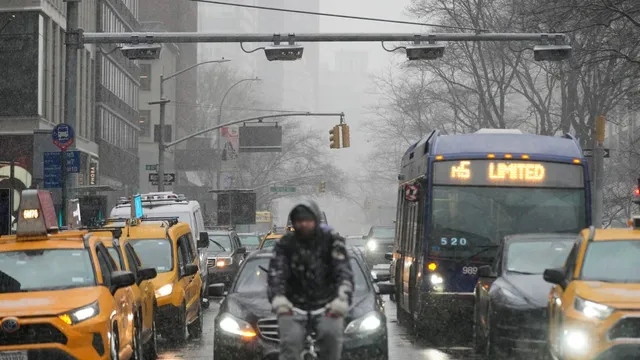
New York city forces drivers to pay new tax for entering manhattan
2025-01-14 11:00- The congestion pricing program was introduced to ease traffic congestion and fund public transit improvements in New York City.
- Data indicates a significant reduction in traffic, with 43,000 fewer cars entering Manhattan daily following the toll's implementation.
- The program's success may influence future traffic management strategies across other U.S. cities.
Express your sentiment!
Insights
On January 5, 2025, New York City implemented a congestion pricing plan that charges most passenger cars $9 to enter below Central Park during peak hours. This initiative aims to reduce traffic congestion while generating revenue for the city's public transit system, which faces financial challenges. Early data from the Metropolitan Transportation Authority indicates that traffic within the tolling zone fell by 7.5%, equating to approximately 43,000 fewer vehicles daily compared to the same period last year. This program is the first of its kind in the United States, following similar successful models in cities such as London and Singapore. The tolling zone's most significant traffic reductions were noted during rush hours, with some crossings experiencing travel time reductions of over 40%. Despite these improvements, the impact on public transit usage remains unclear, with anecdotal evidence suggesting that subway ridership has not markedly increased, as the baseline remains over three million daily users. However, certain bus routes from Brooklyn and Staten Island have recorded increased ridership, reflecting a potential shift in commuter habits. The congestion pricing initiative commenced after years of debate and was temporarily halted by New York Governor Kathy Hochul, who had initially supported the program but reversed her stance due to public concerns about its economic implications. The governor eventually revived the initiative at a lower toll rate of $9 instead of the proposed $15. Advocates of congestion pricing argue that it is essential for improving the city's transportation infrastructure while reducing environmental impacts commonly associated with high traffic volumes. In the wake of the new toll system, various stakeholders expressed mixed sentiments. Some New Yorkers have raised concerns about the potential financial burden on lower-income residents and local businesses, while others applaud the initiative as a necessary step for modernizing and funding public transit. Advocacy groups have noted the importance of communicating the benefits of such a program to gain public support over time, similar to experiences noted in other cities that have undergone congestion pricing. As the city continues to adjust to the implications of congestion pricing, the long-term effects on traffic patterns and public transportation efficiency remain to be seen.
Contexts
Congestion pricing has gained traction as a transportation management tool in urban centers facing severe traffic strain. Major cities such as London, Singapore, and New York City have implemented varied forms of congestion pricing to tackle issues such as traffic congestion, environmental pollution, and funding public transportation infrastructure. The core concept is to charge drivers for using certain roads during peak hours, thereby discouraging unnecessary trips and promoting the use of alternative transportation methods. The effectiveness of these programs, however, depends on their design, public acceptance, and the specific urban context in which they are implemented. In London, the introduction of congestion pricing in 2003 significantly reduced traffic volumes in the central zone. The charge has resulted in a 30% decrease in traffic congestion, improved air quality, and increased the reliability of public transport. Revenue generated from the system has been earmarked for the enhancement of public transportation services, fulfilling the dual purpose of reducing congestion while simultaneously investing in a more sustainable infrastructure. Public acceptance grew over time, as the benefits of reduced congestion and improved public transport became evident, making it a model for other cities considering similar measures. Singapore's approach to congestion pricing is characterized by its Electronic Road Pricing (ERP) system, which utilizes technology to dynamically adjust tolls based on real-time traffic conditions. This system has been particularly effective in managing peak hour congestion and has led to a more efficient use of road capacity. The success of Singapore's ERP system is attributed not only to the technology employed but also to the city's integrated urban transport policy, which includes well-developed public transportation options, making alternatives to driving more viable for residents. The city's experience demonstrates that integrating congestion pricing with a broader traffic management strategy can lead to sustained improvements in urban mobility. On the other hand, New York City's attempt to implement congestion pricing has faced more challenges, particularly regarding public pushback and political hurdles. After years of discussion, New York may look to lessons learned from London and Singapore, placing an emphasis on visibly improving public transportation before charging drivers for road use. Successful implementation in New York could signify a critical turning point for urban congestion management in the United States. The final outcomes of congestion pricing implementations in different cities show a path forward for urban centers grappling with the pressures of increased vehicular traffic, offering strategies to enhance sustainability and livability.